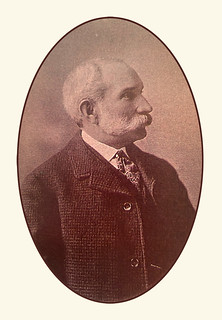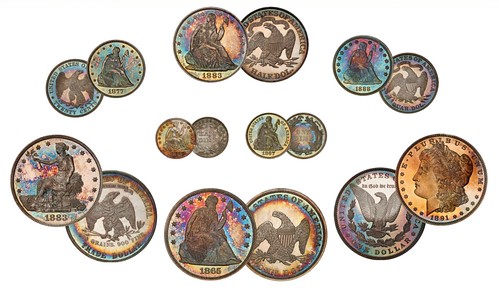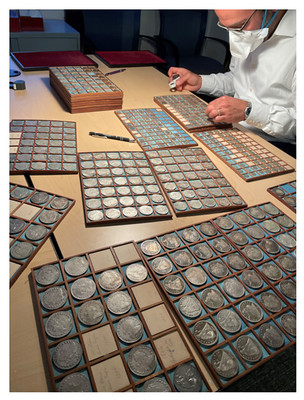
PREV ARTICLE
NEXT ARTICLE
FULL ISSUE
PREV FULL ISSUE
THE JAMES ALLAIRE MILLHOLLAND COLLECTIONVicken Yegparian penned a great article about the recent discovery of an intact nineteenth-century American coin collector's cabinet, nowadays the equivalent of opening King Tut's tomb. With permission, we're republishing it here. Thank you - fascinating story! -Editor
The Fascinating Numismatic Cabinet of
James Allaire Millholland, 1842-1911
As numismatists, we at Stack's Bowers Galleries are often interested in the history of a collection, especially how it evolved into the finished product that graces the pages of our auction catalogs. Sometimes that history is rich, such as with the famed Garrett and Eliasberg collections, carrying so much associated information behind them that entire books have been written about these American cabinets. The cabinet of James Allaire Millholland (JAM), who lived from 1842 to 1911, on the other hand, is today witnessed only by the coins themselves and a small handwritten ledger he kept as an inventory of the collection. The story we can weave is based solely on the evidence of the coins and the man, and how they intersect is unknown, as no records exist of his individual acquisitions or how he embarked on his numismatic journey. His numismatic path seemingly has left no wake, and he does not appear to have been a member of major numismatic organizations of the day, such as the American Numismatic Association and the American Numismatic Society. We do know that the coins descended in the family of Millholland's 16th and final child, James Millholland (JM), and were kept reverentially within the family—they were regarded more emotionally than monetarily, a most tangible link to a father (JAM) who passed away before he (JM) was even seven years old. The quality of the coins is a testament to the care with which the coins were held within the family for well over a century past James Allaire Millholland's passing in 1911. According to his grandchildren, the coins were for a long time kept out of sight by their father in their custom cabinet in an alcove behind the furnace in the family home and were later moved to the far back of their father's closet, before finally being moved to a safe deposit box under their care. As you peruse the listings of the collection, you will immediately notice the fine cabinet toning, sometimes quite vivid and electric, that enhances so many of the coins. We would like to think that the heat thrown off by the nearby furnace sparked and accelerated these wonderful tones on the coins sitting on paper inserts in neat little rows on trays in the wooden cabinet built by the crafty JAM himself. And being tucked away rather than constantly handled preserved the uniformly high quality of the collection, especially among the Proof coins which are prevalent starting with the issues of the 1860s and are almost exclusively graded in the Proof-64 to Proof-67 range. There are also many very original and beautiful circulated and Mint State coins in the earlier issues. As a further testament to its originality and high quality, the collection as a whole received a greater than 40% CAC acceptance rate among CAC-eligible items, and taken alone, the Proofs received CAC approval at a rate of more than 55%! The road taken by the collection to these pages has been a long one. We know from the evidence of the coins themselves that the collection was built in the 19th century, as the last coins in the cabinet and recorded by JAM were in 1894. Though there is no evidence or family lore as to why he stopped collecting 17 years before his death in 1911, his grandchildren surmise that the extended illness which led to his first wife's death in 1896 might have been an influence. His grandchildren, caring for the coins for many decades, tracked the trajectory of Stack's and then Stack's Bowers Galleries as the firm made numismatic headlines. But it wasn't until the summer of 2022—fully 111 years after their grandfather's passing—that they brought the coins to us. Working with Andrew Bowers, the family made an appointment for an evaluation. Blurry yet tantalizing photos of the trays were sent in advance. Hard to interpret, the photos showed trays full of coins that easily could have represented two extremes—they were either trays of well circulated coins or Gems, we couldn't be sure. So, the excitement of discovery was left to the day when the coins crossed the threshold of our New York City flagship gallery at 470 Park Avenue.
When the cabinet was first opened in our conference
room, everyone's jaws dropped. The coins were neither
uniformly circulated nor uniformly Gems but were a wonderful mixture of the two. Though the
We imagine that the collection was built by two methods: from circulation and by purchases from coin dealers. Though not presented in this catalog, there were about 100 pieces in the cabinet that are of modest value, chiefly well used copper half cents and large cents and silver Liberty Seated issues that could have been plucked from loose change or an old family accumulation. More poignantly, JAM's ledger inventorying his coin collection lists a number of dealers from whom he must have purchased many of the most significant coins: familiar 19th century names like Scott and Co. of New York and Philadelphia dealers J.W. Haseltine, A.M. Smith, Mason & Co., and S.H. & H. Chapman. Less familiar or perhaps unheralded dealers include R.W. Mercer of Cincinnati, M.F. Blacy(?) of New York City, and F.R. Bavis(?) of Philadelphia, the latter two names difficult to decipher in Millholland's handwritten ledger.
Fully one-third (180 of about 540) of the coins in this
auction are 19th century Proofs, with some years represented by complete Proof
Following this introduction is a brief but pithy biography
of James Allaire Millholland provided by his grandchildren,
which will give you a better feel for the man responsible for
the collection that is presented here. Unable to attend in
person a meeting at Stack's Bowers Galleries in New York
to discuss the auction, one of his octogenarian grandchildren wrote This undertaking feels a bit as if we are getting to honor a grandfather we never had the chance to know. Though we are not family, Andrew and I and all of us at Stack's Bowers Galleries feel like honorary members of the Millholland clan, as we too have been enthralled by this adventure and are excited to present this fascinating cabinet to collectors in the 21st century. I could blather on for many more pages talking about individual coins, but I will instead allow my colleague Jeff Ambio's masterful cataloging and the images do the talking for each piece. I encourage you to peruse the listings of the collection presented in three places in this Official Auction of the Whitman Baltimore Spring Expo: our Rarities Night (lots 3001-3056), Live (lots 4001-4229) and Internet (lots 9329-9581) sessions. There are truly coins for collectors of all stripes, whether you are looking for an inexpensive souvenir of a not-yet-famous collection or for a five-figure condition rarity destined for a top registry set. Once dispersed, we imagine these 540 or so coins will not often reappear in the numismatic market, cherished by their new owners as a connection to an unheralded 19th century collector and as remarkably high-quality survivors of their respective issues.
Vicken Yegparian
To view or bid on the Millholland coins, see:
Wayne Homren, Editor The Numismatic Bibliomania Society is a non-profit organization promoting numismatic literature. See our web site at coinbooks.org. To submit items for publication in The E-Sylum, write to the Editor at this address: whomren@gmail.com To subscribe go to: https://my.binhost.com/lists/listinfo/esylum All Rights Reserved. NBS Home Page Contact the NBS webmaster 
|



